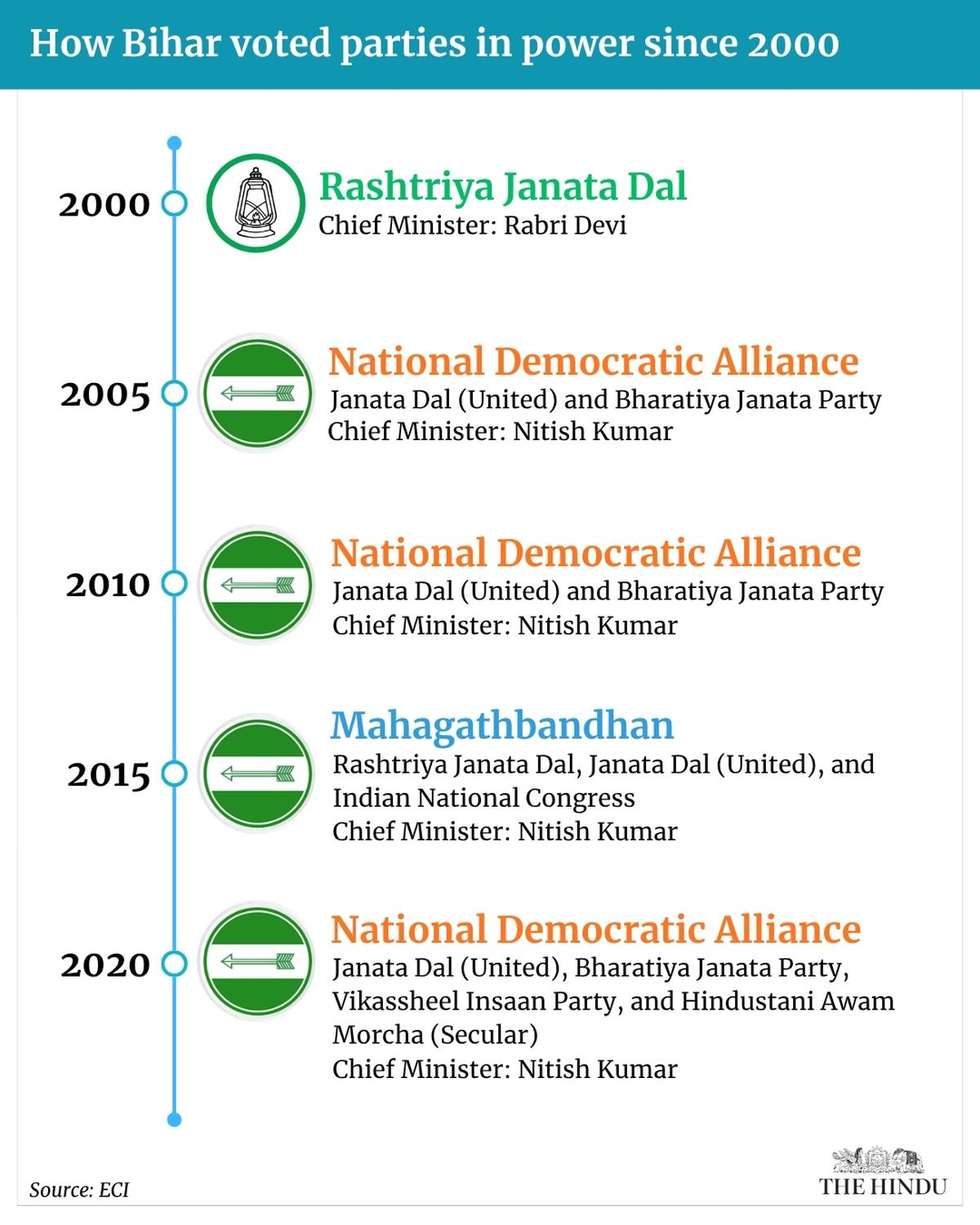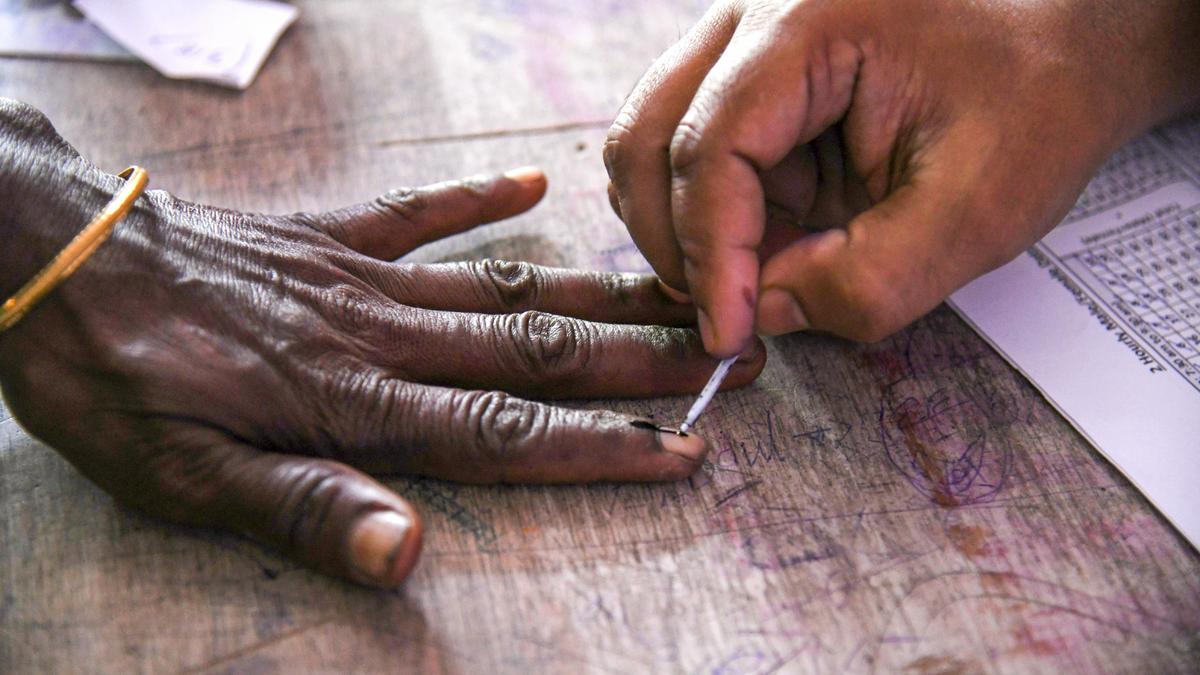A high-stakes political battle in the Bihar Assembly Elections 2025 is all set, with voting to be held on November 6 and 11 and the results to be announced on November 14 for all 243 seats. The contest is again between the incumbent National Democratic Alliance (NDA) and the opposition Mahagathbandhan (Grand Alliance), which marks a significant turn in Bihar coalition politics.
Over the past two decades, the State has witnessed dramatic changes in voter behavior, alliance structures, and political loyalty. The Grand Alliance, once a cohesive force under Tejashwi Yadav’s leadership, is struggling with internal rifts with the coalition staring at direct contests on 11 seats among its own partners. RJD and Congress are set to clash on six seats, Congress and CPI on four, and the Vikassheel Insaan Party (VIP) is challenging the RJD in Chainpur. Meanwhile, the Janata Dal (United) (JD(U)) will stick with the BJP-led NDA.

How Bihar voted parties in power since 2000
From the dominance of RJD to Nitish Kumar’s long-standing regime, Bihar elections have consistently seen shifts in caste alignments, power equations, and voting patterns since 2000. This pattern of change will again decide the fate of Bihar.

2000: The Bihar Assembly elections in 2000 resulted in a hung verdict. The RJD emerged as the single largest party with 124 seats out of 324, but with no clear majority. As a Samata party leader, Nitish Kumar was backed by the BJP and became the Chief Minister of Bihar for the first time. NDA and its allies had only 151 MLAs against RJD’s 159 MLAs. After seven days, Mr. Kumar had to resign as he couldn’t prove a majority in the house. Later, Rabri Devi proved her majority with the support of several parties, including the Congress and the Left. The seat equations also changed in less than a year as the State of Jharkhand was separated from Bihar on November 15, 2000, reducing the size of the assembly to 243 seats.

2005: Bihar witnessed two elections in 2005. The election held in February gave a hung verdict, leading to President’s rule. The re-election in October brought JD(U)-BJP alliance into power, ending the RJD’s longstanding dominance. JD(U) won 88 seats and BJP 55, and Mr. Kumar became the Chief Minister.
2010: NDA achieved a landslide victory of 206 seats out of 243, with JD(U) securing 115 seats and BJP winning 91 seats. Mr. Kumar again became the Chief Minister but stepped down in 2014, following the JD(U)’s poor performance in the Lok Sabha election. The BJP, which fared better demanded his resgination. Jitan Ram Manjhi from JD(U) became the CM.
2015: A dramatic turn came in 2015 when JD(U) joined hands with former rival RJD and the Congress to form the Mahagathbandhan. The coalition secured a major victory over the NDA, winning 178 seats -RJD with 80, JD(U) with 71, and Congress with 27. Mr. Kumar again became the Chief Minister. But in 2017, Mr. Kumar broke with RJD over corruption allegations, leading to his return to NDA.
2020: Though RJD managed to emerge as the single largest party with 75 seats, it was the NDA that secured a narrow win. The BJP secured 74 seats, JD(U) got 43, with allies VIP and Hindustani Awam Morcha (Secular) (HAM(S)) contributing four seats each. With a total of 125 seats, Mr. Kumar became the Chief Minister for the seventh time.
Nitish Kumar’s political journey
Nitish Kumar entered politics as a member of Janata Dal and was elected to the State Assembly as an MLA in 1985. As someone who lobbied for Lalu Prasad, Mr. Kumar got all the support for Mr. Prasad for the Chief Minister’s post in 1990. But in 1994, a group of 14 Janata Dal MPs revolted against Mr. Prasad, lining up behind socialist stalwart George Fernandes and naming the group Janata Dal (George). While Fernandes was the face of the group, Mr. Kumar was its creator. The group later renamed itself the Samata Party.

In 1996, Mr. Kumar switched his loyalties to the BJP. In 2000, he became the Chief Minister for the first time, but lasted only seven days. He became the CM again in 2005. With a tenure of 18 years, Mr. Kumar is the longest-serving Chief Minister of Bihar and also has a record of switching sides- three times. Even after the continuous change in alliance between the BJP and the RJD, Mr. Kumar managed to continuously win in all the elections since 2005 and became the Chief Minister seven times.
BJP’s rise and JD(U)’s decline
In the 2005 and 2010 assembly elections, JD(U) was a major party in alliance with the BJP, showing a strong show of power by the party by securing 88 and 115 seats respectively. It was JD(U)’s peak and played a dominant regional force in the State with BJP in an allied role. But JD(U)’s decline began in 2015 with a drop in the number of seats (71) when it joined Mahagathbandhan. Even though the alliance worked and formed a government, it was not the largest party anymore.
The 2020 election was no different for JD(U) in terms of the number of seats, as it again dropped to 43, even after returning to the NDA, paving the way for the BJP’s immense growth in the State, which eventually led to both parties contesting in equal number of seats in the 2025 assembly elections. While JD(U) fell from 88 seats in 2005 to 43 in 2020, BJP’s strength went up from 55 to 74 seats. While BJP emerged as the stronger force in the alliance, JDU’s influence weakened, to a point where JD(U) was pushed down to third position in 2020 elections. BJP, which was once a small partner has now become a dominant force in Bihar changing the power equations.
RJD factor: voter share since 2000
RJD has consistently maintained the highest vote share among RJD, BJP, and JD(U) and has been the single largest party with most number of seats secured in 2000, 2015 and 2020. In its heyday, the RJD received 28 per cent of the vote share, in both 1995 and 2000. In the two elections in 2005, it received 25.07 per cent and 23.45 per cent, and its vote share had dropped to 18.84 per cent in 2010 and to 18.35 per cent in 2015.
With Tejashwi Yadav’s youth factor and with a consistent political positioning, the party has tried to manage its voter share till the 2020 elections. Even though the vote share declined post-2000 elections, it again climbed up in 2020 with 23.11 per cent.
Voter turnout trends
The highest voter turnout in Bihar’s history was in the 2000 assembly election, with 62.6% polling, but there was a sharp drop in 2005 (both elections) to below 50%. It was the year of political instability, and there were two elections in the same year which possibly led to a decline in voter turnout.
The turnout gradually climbed again from 2010 to 2015 and almost flattened by 2020 with a polling percentage of 57.1. There was also a rise in women voter participation in the last two elections.
Published – October 25, 2025 10:54 am IST
